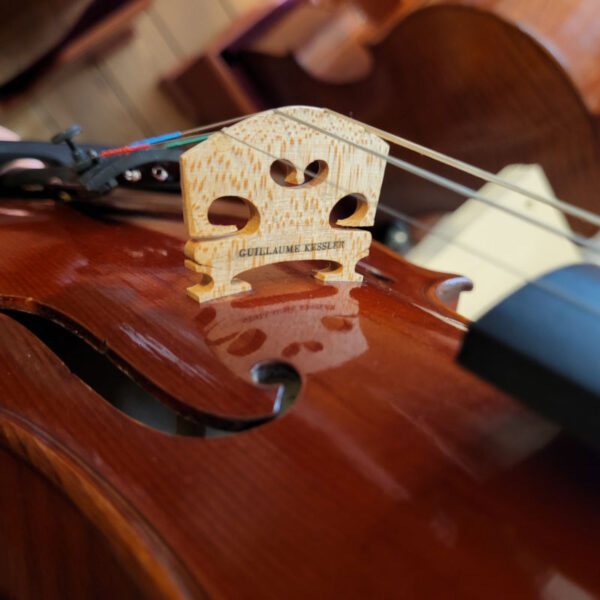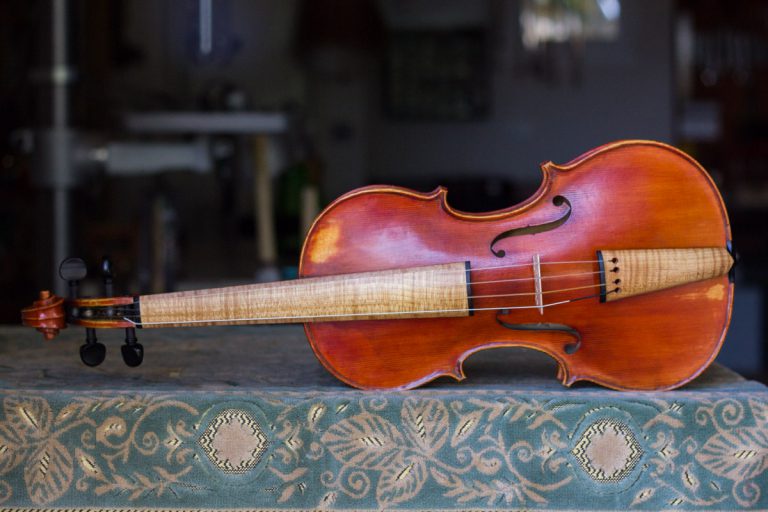In this article, I'm going to let you in on all the secrets of violin string tension. Well, I may be exaggerating a little, but one thing's for sure: this will be an excellent tool. It will enable you to compare strings and make an informed choice.

Violin string tension
One of the determining factors in the sound of a violin is without doubt its tension. In fact, the entire instrument is under tension, even at rest. It will determine the instrument's power and ability to vibrate, and will be accompanied by meticulous selection work to achieve the best result.
The main tool I've created in this article is a comparison table between the main sets of violin strings I offer in the online store. Its ultimate aim is to represent the full range of possibilities available on the market.
Knowing the tension of violin strings
This article aims to help you understand and choose the most suitable violin string tensions for your instrument. Here are a few points to help you understand what's involved.
What does string tension imply?
Tension is a physical quantity expressed in terms of mass, such as a gram, kilogram or pound. In fact, it represents the force exerted on the rope to put it under tension. So, for a tension of, say, 10kg, this means that a rope attached to the ceiling at one end will carry a load of 10kg at the other.
This somewhat simplistic example does not represent the complexity of the string's path on a violin, to which different frictions and angles are applied, breaking its trajectory. It does, however, give a concrete idea of the force exerted on the string.
This tension is created by the force exerted by the peg and tailpiece, which stretch the string as it vibrates in harmony with an A at 440 Hertz. In other words, if the string is not an A, it will be a note harmonized with the A string according to a standard tuning in fifths for the other strings, i.e. G, D and E.
To better understand how to tune a violin, please consult this article.
How does the tension feel?
You can feel the tension under your fingers, but also in your ears.
A more or less taut string will be felt directly. Thus, for a beginner, less taut strings are generally easier to play because they are less hard to press. On the other hand, tighter strings will have more response and be more reactive under the fingers of the most agile (and fast) musicians.
To the ear, a taut string will generally have more power and range. However, a looser string will be more vibrant and richer.
Depending on the instrument, its structure and mounting, certain tensions will work better than others. As a result, some violins will take high tensions easily, while others simply won't stand them.

For more information on what your instrument can and cannot handle, please contact your luthier.
Comparing string tensions
Here is a classification of strings according to the total tension applied to the violin. First and foremost, you need to take into account the reference vibrating length, which may slightly alter the result. On the other hand, depending on the mounting, the actual result may also vary slightly. But in this case, we consider that all standards are respected.
For vibrating length
You'll notice in the table that different manufacturers use different vibrating lengths to calculate tension. I've listed them all in the table to give you a better idea of what's involved. However, according to my calculations, which I'll gladly leave to the more physicist among you to recalculate, the maximum difference in amplitude would be of the order of 1.5% variation between the shortest and longest LV. So, in my opinion, it's rather negligible. However :
- For a shorter vibrating length: Tension increases at the same tuning
- For a longer vibrating length: Tension decreases at the same tuning
To find out more about vibrating strings, you can consult a huge number of online resources. I can also recommend James BEAMENT 's The Violin Explained.
How to read the table :
- String set name: Name and link of the string set in the store
- Set tension: Tension indicated on the string set according to the manufacturer's classification. If only one is available, it will automatically be assigned the "Medium" tension.
- Core: what makes up the inside of the string, whether gut, synthetic or metal.
- Reference LV: The reference vibrating length used to calculate tensions. This varies slightly from one manufacturer to another, so it must be taken into account when adjusting the result.
- The tensions for each violin string (in 4/4 size) as well as their total tension.
| String name | Set tension | Soul | Reference LV (mm) | G-Sol (kg) | D-Ré (kg) | A-La (kg) | E-Mi (kg) | Total voltage (kg) |
|---|---|---|---|---|---|---|---|---|
| Solea | Low | Synth | 325-330 | 4,4 | 3,95 | 4,85 | 7,3 | 20,5 |
| Solea | Medium | Synth | 325-330 | 4,6 | 4 | 4,95 | 7,95 | 21,5 |
| Dominant | Medium | Synth | 325 | 4,2 | 4,5 | 5,5 | 7,2 | 21,6 |
| New Crystal | Low | Synth | 325-330 | 4,55 | 4,25 | 5 | 8 | 21,8 |
| Cantiga | Low | Synth | 325 | 4,6 | 4,4 | 5,1 | 7,8 | 21,9 |
| Aricore | Std | Synth | 325 | 4,2 | 4,5 | 5,6 | 7,7 | 22 |
| Aurora | Medium | Synth | 325 | 4,5 | 4,2 | 5,5 | 7,8 | 22 |
| Passione | Std | Boy. | 325 | 4,6 | 4,9 | 5,0 | 7,8 | 22,3 |
| Alphayue | Std | Synth | 325 | 4,5 | 4,5 | 5,5 | 7,9 | 22,4 |
| Aurora (ag) | Medium | Synth | 325 | 4,5 | 4,7 | 5,5 | 7,8 | 22,5 |
| Evah Pirazzi | Medium | Synth | 325 | 4,8 | 4,6 | 5,3 | 7,8 | 22,5 |
| Solea | Strong | Synth | 325-330 | 4,8 | 4,1 | 5,2 | 8,5 | 22,6 |
| Karneol | Std | Synth | 326 | 4,4 | 4,4 | 5,6 | 8,2 | 22,6 |
| Tonica Gold Label | Std | Synth | 325 | 4,9 | 4,5 | 5,5 | 7,7 | 22,6 |
| Dominant Pro | Std | Synth | 325 | 4,6 | 4,5 | 5,5 | 8 | 22,6 |
| Amber | Std | Synth | 326 | 4,4 | 4,4 | 5,5 | 8,4 | 22,7 |
| New Crystal | Medium | Synth | 325-330 | 4,75 | 4,45 | 5,3 | 8,6 | 23,1 |
| Alliance Vivace | Medium | Synth | 330 | 4,8 | 4,6 | 5,1 | 8,6 | 23,1 |
| Evah Pirazzi | Medium | Synth | 325 | 5,3 | 4,9 | 5,6 | 7,8 | 23,1 |
| Cantiga | Medium | Synth | 325 | 4,8 | 4,6 | 5,3 | 8,5 | 23,2 |
| Rondo Gold | Std | Synth | 325 | 4,7 | 4,7 | 5,6 | 8,2 | 23,2 |
| Timbre (A synth.) | Medium | Synth | 326 | 4.65 | 4.7 | 5.5 | 8.5 | 23,4 |
| Peter Infeld PI100 | Std | Synth | 325 | 4,7 | 4,8 | 5,6 | 8,3 | 23,4 |
| Rondo | Std | Synth | 325 | 4,8 | 4,8 | 5,7 | 8,2 | 23,5 |
| New Crystal | Strong | Synth | 325-330 | 5 | 4,75 | 5,6 | 8,6 | 23,95 |
| Evah Pirazzi | Strong | Synth | 325 | 5,3 | 5 | 5,9 | 8,2 | 24,4 |
| Helicore | Medium | Met. | 328 | 4,62 | 5,21 | 5,76 | 8,43 | 24,02 |
| Stamp (A steel) | Std | Synth | 326 | 4.65 | 4.7 | 6,66 | 8,5 | 24,5 |
| Aurora (alu) | Strong | Synth | 325 | 4,9 | 5,4 | 5,8 | 8,4 | 24,5 |
| Aurora (ag) | Strong | Synth | 325 | 4,9 | 5,5 | 5,8 | 8,4 | 24,6 |
| Prelude | Std | Met. | 328 | 5,2 | 5,3 | 5,9 | 8,4 | 24,8 |
Table analysis
Several things become striking when all the information is centralized and compared.
In particular, it's easy to appreciate that "medium" tension strings can cover the entire tension range: from the lowest to the highest. So beware of different tension ranges, and concentrate instead on the exact tension figures.
The world's most frequently used strings, the Dominants, are at the very bottom of the tension chart. Does this mean that most instruments perform better at lower tensions?
The least taut strings
- Soléa (low) = 20.5
- Soléa (medium) = 21.5
- Dominant (medium) = 21.6
It's interesting to note that Soléa strings are by far the least tense, both in the medium and low models. These are really tensions that can correspond to very delicate instruments.
I'm going to continue my quest to determine which set of ropes will be the least tense.

The tightest strings
- Prelude (Std) = 24.8
- Aurora (Strong) = 21.5
- Stamp (Std) = 24.8
A big surprise in the ranking of the tightest strings. These include two strings that can be considered beginners' strings. In particular, the Prelude seems quite taut for beginner fingers. That said, this is undoubtedly to give sufficient force to the vibration of the thickest student instruments.
A work in progress
At the moment, I'm doing a great deal of work on all violin strings. So I'm going to use the information I share in this table to come to some conclusions. In the meantime, I'm making it available and will gradually complete the information to include information on all string sets on the market today. This will provide a very accurate compilation of all the information, and hopefully you'll be able to use it to draw up a roadmap for your next sound explorations.






